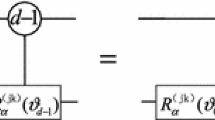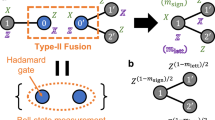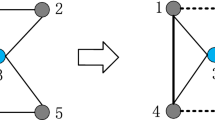Abstract
Generating entangled states efficiently is a hot topic in the area of quantum information science. With the approach presented in this paper, a general parity gate could be realized and a wide range of entangled states, including GHZ state, W state, Dicke state, arbitrary graph state and locally maximally entanglable states, can be generated flexibly. The generation of GHZ state, W state, and Dicke state is probabilistic but heralded and the total success probability is unit. In addition, the arbitrary graph state and locally maximally entanglable states generation is deterministic, flexible, and highly efficient. Especially, with the “simultaneous” generation pattern, the complexity of the graph state generation and locally maximally entanglable states generation could be reduced greatly, providing a more efficient and feasible way to generate the entangled states.
Similar content being viewed by others
References
Nielsen M A, Chuang I L. Quantum Computation and Quantum Information. Cambridge: Cambridge University Press, 2000
Bennett C H, Brassard G, Crepeau C, et al. Teleporting an unknown quantum state via dual classical and Einstein-Podolsky-Rosen channels. Phys Rev Lett, 1993, 70: 1895–1899
Bennett C H, Wiesner S J. Communication via one- and two-particle operators on Einstein-Podolsky-Rosen states. Phys Rev Lett, 1992, 69: 2881–2884
Bouwmeester D, Pan JW, Daniell M, et al. Observation of three-photon Greenberger-Horne-Zeilinger entanglement. Phys Rev Lett, 1999, 82: 1345–1349
Zhao J Q, Lu H X, Wang X Q. Preparation of generalized Greenberger-Horne-Zeilinger and measurement of nonlocality (in Chinese). Sci Sin-Phys Mech Astron, 2011, 41: 1198–1202
Zhao Z, Yang T, Chen Y A, et al. Experimental violation of local realism by four-photon greenberger-horne-zeilinger entanglement. Phys Rev Lett, 2004, 91: 180401
Cao L Z, Zhao J Q, Wang X Q, et al. Experimental preparation and nonlocality of the high-pure four-photon Greenberger-Horne-Zeilinger states (in Chinese). Sci Sin-Phys Mech Astron, 2013, 43: 1079–1083
Huang Y F, Liu B H, Peng L, et al. Experimental generation of an eight-photon Greenberger-Horne-Zeilinger state. Nat Commun, 2011, 2: 546
Yao X C, Wang T X, Xu P, et al. Observation of eight-photon entanglement. Nat Photon, 2012, 6: 225–228
Yao X C, Wang T X, Chen H Z, et al. Experimental demonstration of topological error correction. Nature (London), 2012, 482: 489–494
Dür W, Vidal G, Cirac J I. Three qubits can be entangled in two inequivalent ways. Phys Rev A, 2 2000, 62: 062314
Dür W.M Multipartite entanglement that is robust against disposal of particles. Phys Rev A, 2 2001, 63: R020303
Koashi M, Buåek V, Imoto N. Entangled webs: Tight bound for symmetric sharing of entanglement. Phys Rev A, 2000, 62: R050302
Joo J, Lee J, Jang J, et al. Quantum secure communication via a W state. J Korean Phys Soc, 2005, 46: 763–768
D’Hondt E, Panangaden P. The computational power of the W and GHZ states. Quantum Inf Comput, 2006, 6: 173–183
Dicke R H. Coherence in spontaneous radiation processes. Phys Rev, 1954, 93: 99–110
Hillery M, Bužek V, Berthiaume A. Quantum secret sharing. Phys Rev A, 1 1999, 59: 1829–1834
Murao M, Jonathan D, Plenio M B, et al. Quantum telecloning and multiparticle entanglement. Phys Rev A, 1999, 59: 156–161
Karlsson A, Bourennane M. Quantum teleportation using three-particle entanglement. Phys Rev A, 1998, 58: 4394–4400
Zhao Z, Chen Y A, Zhang A N, et al. Experimental demonstration of five-photon entanglement and open-destination teleportation. Nature (London), 2004, 430: 54–58
Kiesel N, Schmid C, Tóth G, et al. Experimental observation of four-photon entangled dicke state with high fidelity. Phys Rev Lett, 2007, 98: 063604
Chiuri A, Vallone G, Bruno N, et al. Hyperentangled mixed phased dicke states: Optical design and detection. Phys Rev Lett, 2010, 105: 250501
Chiuri A, Greganti C, Paternostro M, et al. Experimental quantum networking protocols via four-qubit hyperentangled Dicke states. Phys Rev Lett, 2012, 109: 173604
Prevedel R, Cronenberg G, Tame M S, et al. Experimental realization of Dicke states of up to six qubits for multiparty quantum networking. Phys Rev Lett, 2009, 103: 020503
Wieczorek W, Krischek R, Kiesel N, et al. Experimental entanglement of a six-photon symmetric Dicke state. Phys Rev Lett, 2009, 103: 020504
Briegel H J, Raussendorf R. Persistent entanglement in arrays of interacting particles. Phys Rev Lett, 2001, 86: 910–913
Raussendorf R, Briegel H J. A one-way quantum computer. Phys Rev Lett, 2001, 86: 5188–5191
Raussendorf R, Browne D E, Briegel H J. Measurement-based quantum computation on cluster states. Phys Rev A, 2003, 68: 022312
Hein M, Dur W, Eisert J. Entanglement in graph states and its applications. In: Casati G, Shepelyansky D L, Zoller P, et al., eds. Proceedings of the international school of physics “Enrico Fermi” on “Quantum Computers, Algorithms and Chaos”. Amsterdam: IOS Press, 2006
Nielsen M A. Optical quantum computation using cluster states. Phys Rev Lett, 2004, 93: 040503
Browne D E, Rudolph T. Resource-efficient linear optical quantum computation. Phys Rev Lett, 2005, 95: 010501
Bodiya T P, Duan L M. Scalable generation of graph-state entanglement through realistic linear optics. Phys Rev Lett, 2006, 97: 143601
Kok P, Munro W J, Nemoto K, et al. Linear optical quantum computation with photonic qubits. Rev Mod Phys, 2007, 79: 135–174
Walther P, Resch K J, Rudolph T, et al. Experimental one-way quantum computing. Nature (London), 2005, 434: 169–176
Walther P, Aspelmeyer M, Resch K J, et al. Experimental violation of a cluster state Bell inequality. Phys Rev Lett, 2005, 95: 020403
Kiesel N, Schmid C, Weber U, et al. Experimental analysis of a four-qubit photon cluster state. Phys Rev Lett, 2005, 95: 210502
Lu C Y, Zhou X Q, Gühne O, et al. Experimental entanglement of six photons in graph states. Nat Phys, 2 2007, 3: 91–95
Tokunaga Y, Kuwashiro S, Yamamoto T, et al. Generation of high-fidelity four-photon cluster state and quantum-domain demonstration of one-way quantum computing. Phys Rev Lett, 2008, 100: 210501
Gao W B, Xu P, Yao X C, et al. Experimental realization of a controlled-NOT gate with four-photon six-qubit cluster states. Phys Rev Lett, 2010, 104: 020501
Kruszynska C, Kraus B. Local entanglability and multipartite entanglement. Phys Rev A, 2009, 79: 052304
Kraus B. Local unitary equivalence of multipartite pure states. Phys Rev Lett, 2010, 104: 020504
Kraus B. Local unitary equivalence and entanglement of multipartite pure states. Phys Rev A, 2010, 82: 032121
Lin Q, He B. Efficient generation of universal two-dimensional cluster states with hybrid systems. Phys Rev A, 2010, 82: 022331
Lin Q, He B. Weaving independently generated photons into an arbitrary graph state. Phys Rev A, 2011, 84: 062312
Lin Q, Li J. Quantum control gates with weak cross-Kerr nonlinearity. Phys Rev A, 2009, 79: 022301
Lin Q, He B. Single-photon logic gates using minimal resources. Phys Rev A, 2009, 80: 042310
Lin Q, He B, Ren Y H, et al. Processing multiphoton states through operation on a single photon: Methods and applications. Phys Rev A, 2009, 80: 042311
Lin Q, He B. Efficient graph state generation and operation error detection with a controlled-path gate. J Phys B: Atom Mol Opt Phys, 2013, 46: 055502
Zhou X Q, Ralph T C, Kalasuwan P, et al. Adding control to arbitrary unknown quantum operations. Nat Commun, 2011, 2: 413
Pittman T B, Fitch MJ, Jacobs B C. Experimental controlled-NOT logic gate for single photons in the coincidence basis. Phys Rev A, 2003, 68: 032316
Ionicioiu R. Entangling spins by measuring charge: A parity-gate toolbox. Phys Rev A, 2007, 75: 032339
Devitt S J, Greentree A D, Ionicioiu R. Photonic module: An ondemand resource for photonic entanglement. Phys Rev A, 2007, 76: 052312
Ionicioiu R, Popescu A E, Munro W J. Generalized parity measurements. Phys Rev A, 2008, 78: 052326
Lin Q. Efficient realization of loss-tolerant optical quantum computation (in Chinese). Sci Sin-Phys Mech Astron, 2011, 41: 1268–1276
Reck M, Zeilinger A, Bernstein H J, et al. Experimental realization of any discrete unitary operator. Phys Rev Lett, 1994, 73: 58–61
Wang C, Zhang Y, Jin G S. Dicke state generation using cross-Kerr nonlinearity. J Mod Opt, 2011, 58: 21–25
Zhao C R, Ye L. Efficient scheme for the preparation of symmetric Dicke states via cross-Kerr nonlinearity. Phys Lett A, 2011, 375: 401–405
Zhao C R, Ye L. Robust scheme for the preparation of symmetric Dicke states with coherence state via cross-Kerr nonlinearity. Opt Commun, 2011, 284: 541–544
Author information
Authors and Affiliations
Corresponding author
Rights and permissions
About this article
Cite this article
Lin, Q. Optical parity gate and a wide range of entangled states generation. Sci. China Phys. Mech. Astron. 58, 1–10 (2015). https://doi.org/10.1007/s11433-014-5620-0
Received:
Accepted:
Published:
Issue Date:
DOI: https://doi.org/10.1007/s11433-014-5620-0




